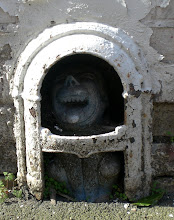The Drive, Fulham Road
The Drive is a small slip road in front of a block of flats that might have been quite grand in its day. The gold paint has faded though and the sign long since ceased to be worth re-painting
 Fulham Road (?)
Fulham Road (?) I know, you're thinking "This one is too clean to be a ghost sign - he must be mistaken?" Well granted it is very clear but apart from the fact that the business is no longer in place, when was the last time you can remember a removals van being called a Pantechnicon? It's one of those words which is crying out for a check on its origins so here goes. From the Wikipedia comes the following explanation
I know, you're thinking "This one is too clean to be a ghost sign - he must be mistaken?" Well granted it is very clear but apart from the fact that the business is no longer in place, when was the last time you can remember a removals van being called a Pantechnicon? It's one of those words which is crying out for a check on its origins so here goes. From the Wikipedia comes the following explanationPantechnicon has become the generic name for vehicles specially designed and constructed to transport furniture, except where "moving van" is usual. This is derived from a building of that name in Motcombe Street, Belgravia, London. The Seth Smith brothers, originally from Wiltshire, were builders in the early 19th century and constructed much of the new housing in Belgravia, then a country area. Their clients required storage facilities and this was built with a Greek style Doric column façade, and called Pantechnicon, Greek for "pertaining to all the arts or crafts". Subsequently special wagons were designed with sloping ramps to more easily load furniture with the building name on the side. The Pantechnicon Ltd, a furniture storage and removal company continued to trade until the 1970s. The building still exists as an antique shop.Parsons Green
This one is so frustrating. It faces a railway line so is a prime site for advertising and it is obvious that the current inhabitants quite like being superimposed on previous signage, but I feel like I'm trying to read this one twenty years too late. Although there are loads of layers of advertising here, it makes it almost impossible to make out more than a few letters at a time. Best of luck if you can make anything out...
 Maybe the top lettering might be easier to read? Maybe not...
Maybe the top lettering might be easier to read? Maybe not... Draycott Mews, New Kings Road
Draycott Mews, New Kings RoadNow bisected by a modern gate this alleyway once led to a printers. Sadly it's now impossible to make out who they were other than the fact they started "W. BR...". You can still see some lettering on the other side of the bars but not enough to make out the name.
 New Kings Road (?)
New Kings Road (?)Last ghost sign on my little perambulation. This one was on the side of a house facing the street and seems partially obscured by what I assume was a later building. It's obviously for a builders merchant as it's offering bricks and sand amongst other items. Pity the white paint is obscuring most of it, but that's the way it goes.






























